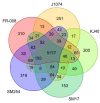Genome Mining Coupled with OSMAC-Based Cultivation Reveal Differential Production of Surugamide A by the Marine Sponge Isolate Streptomyces sp. SM17 When Compared to Its Terrestrial Relative S. albidoflavus J1074
- PMID: 31561472
- PMCID: PMC6843307
- DOI: 10.3390/microorganisms7100394
Genome Mining Coupled with OSMAC-Based Cultivation Reveal Differential Production of Surugamide A by the Marine Sponge Isolate Streptomyces sp. SM17 When Compared to Its Terrestrial Relative S. albidoflavus J1074
Abstract
Much recent interest has arisen in investigating Streptomyces isolates derived from the marine environment in the search for new bioactive compounds, particularly those found in association with marine invertebrates, such as sponges. Among these new compounds recently identified from marine Streptomyces isolates are the octapeptidic surugamides, which have been shown to possess anticancer and antifungal activities. By employing genome mining followed by an one strain many compounds (OSMAC)-based approach, we have identified the previously unreported capability of a marine sponge-derived isolate, namely Streptomyces sp. SM17, to produce surugamide A. Phylogenomics analyses provided novel insights on the distribution and conservation of the surugamides biosynthetic gene cluster (sur BGC) and suggested a closer relatedness between marine-derived sur BGCs than their terrestrially derived counterparts. Subsequent analysis showed differential production of surugamide A when comparing the closely related marine and terrestrial isolates, namely Streptomyces sp. SM17 and Streptomyces albidoflavus J1074. SM17 produced higher levels of surugamide A than S. albidoflavus J1074 under all conditions tested, and in particular producing >13-fold higher levels when grown in YD and 3-fold higher levels in SYP-NaCl medium. In addition, surugamide A production was repressed in TSB and YD medium, suggesting that carbon catabolite repression (CCR) may influence the production of surugamides in these strains.
Keywords: OSMAC; Streptomyces; albidoflavus phylogroup; genome mining; marine sponge-associated bacteria; phylogenomics; secondary metabolites; surugamide A; surugamides.
Conflict of interest statement
The authors declare no conflict of interest.
Figures







References
Grants and funding
LinkOut - more resources
Full Text Sources

